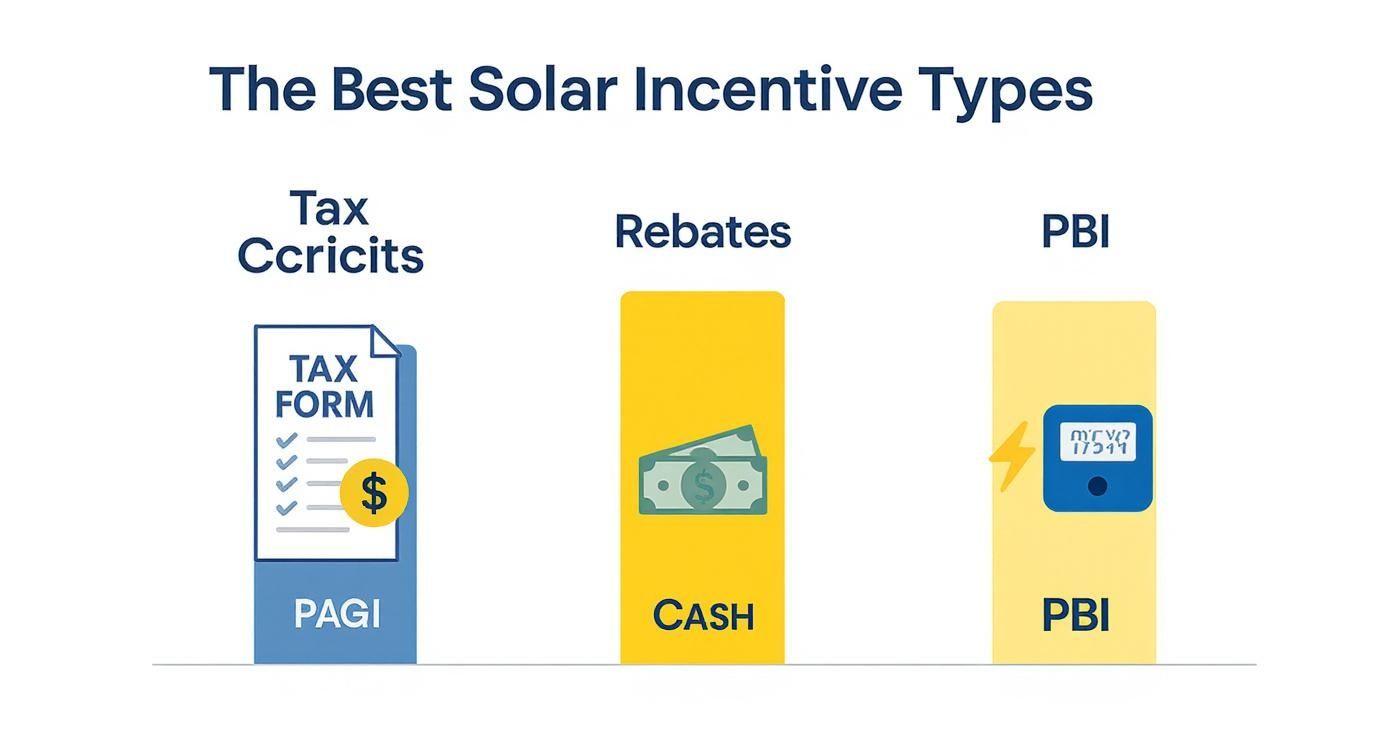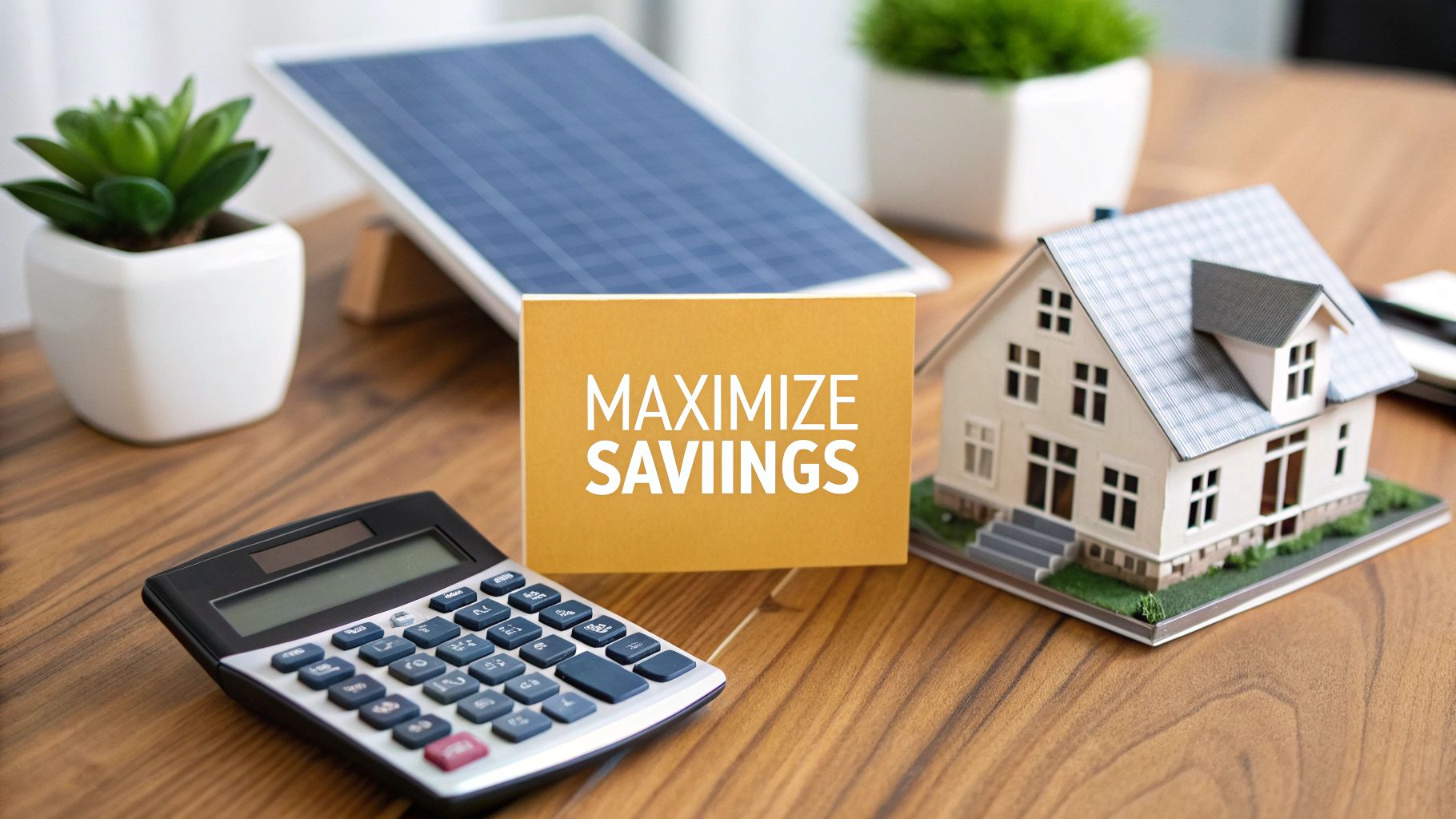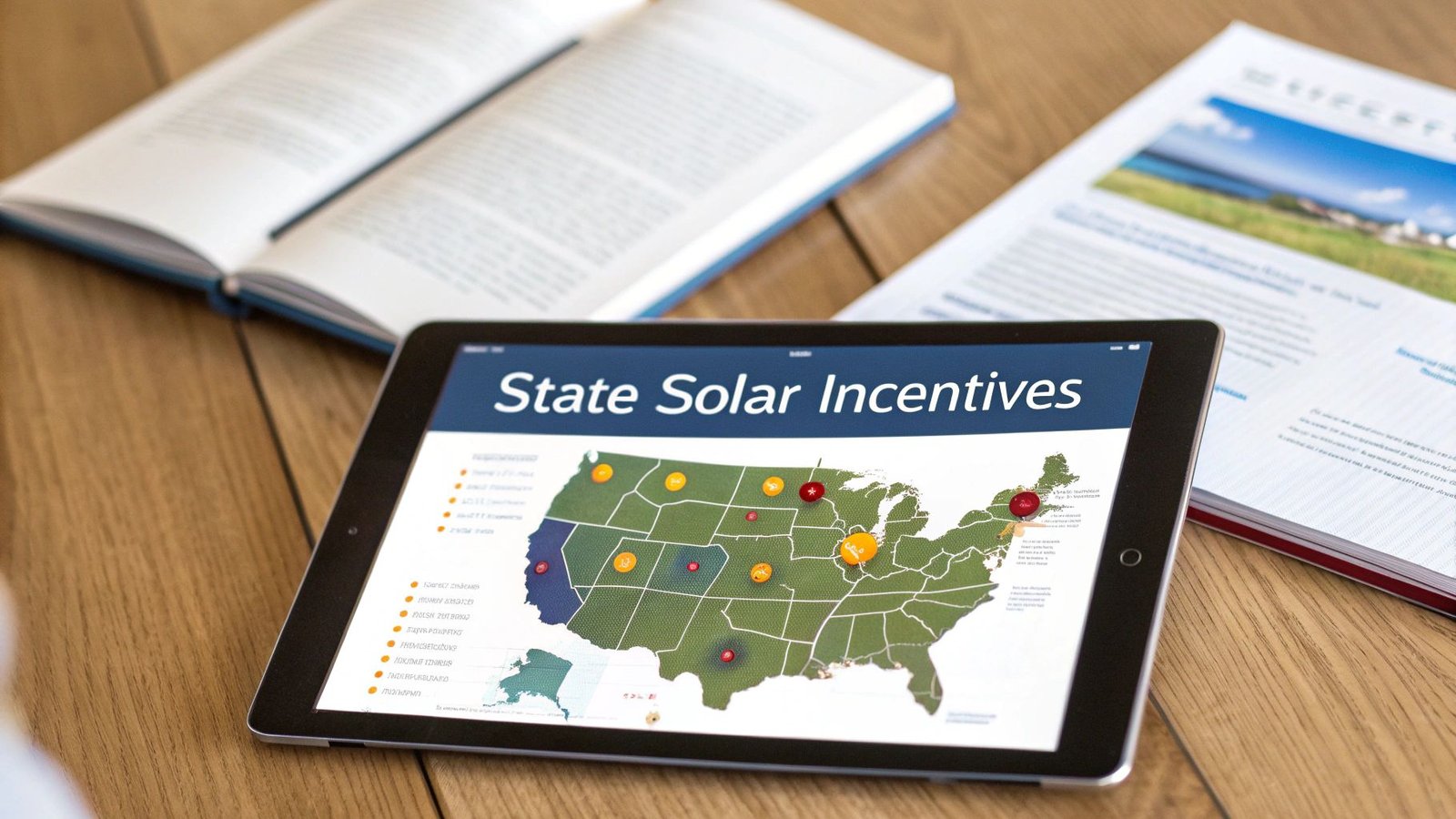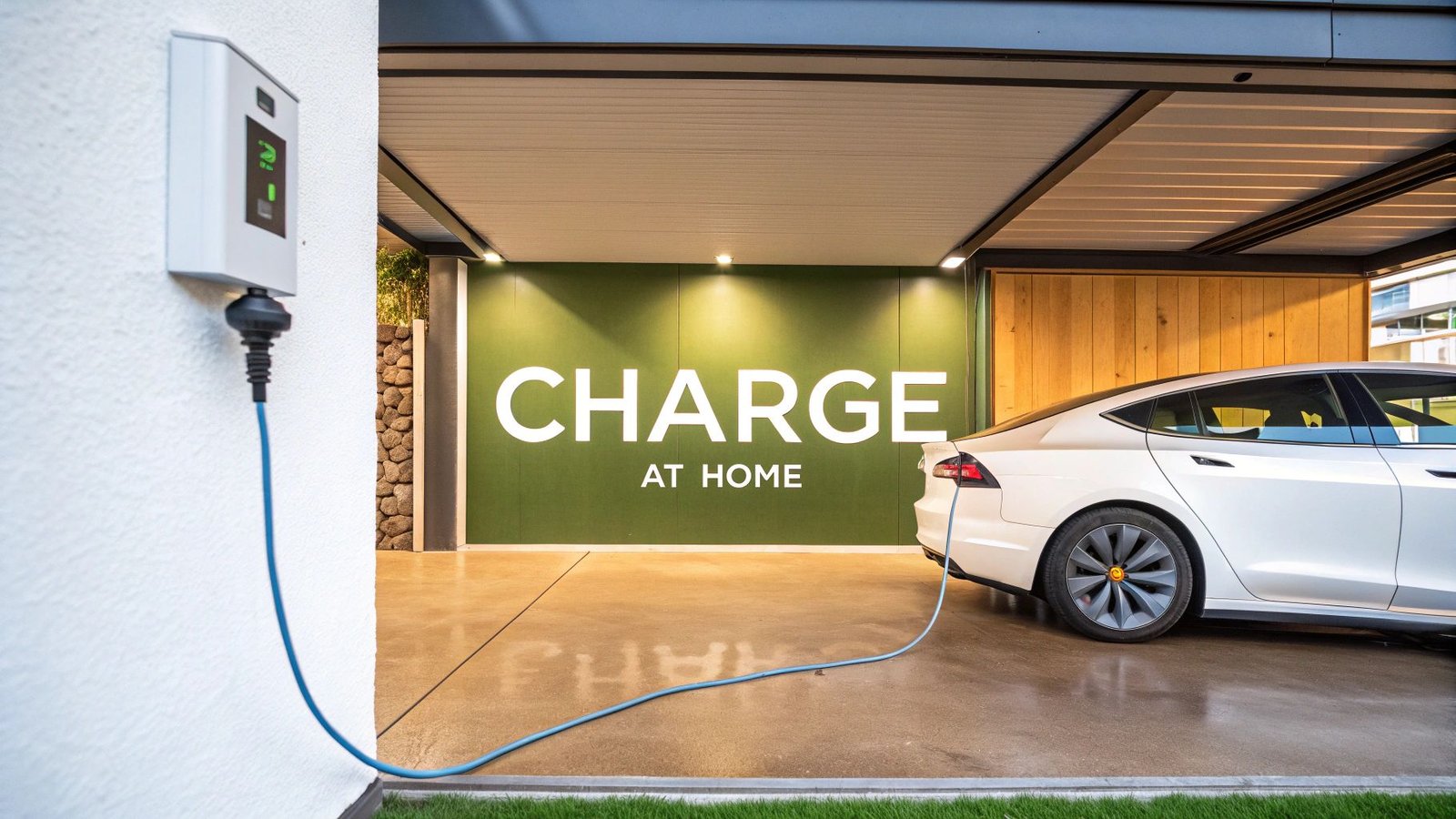Trying to make sense of solar incentives by state can feel like a puzzle, but it's one worth solving. These programs are put in place by federal, state, and even local authorities to dramatically lower the cost of installing solar panels on your home. Think of them as a mix of tax credits, rebates, and special exemptions all designed to make clean energy a more affordable choice for everyone.
Your Quick Guide to Navigating Solar Incentives
Getting a handle on the available financial perks is the first real step in making a smart solar investment. These incentives come in a few different flavors, and each one helps reduce the overall cost of your system in its own way. Some give you an immediate discount right off the bat, while others chip away at your taxes or offer long-term savings.
The biggest one on the table is the federal solar Investment Tax Credit (ITC). This is a game-changer, offering a 30% tax credit on the total cost of any solar system installed between 2022 and 2032. On a typical $29,970 system, that's a direct reduction of $8,991 on your tax bill. But this federal credit is really just the starting point.
The Main Incentive Categories
To really get the most bang for your buck, you need to know what kind of help is out there. They generally fall into a few key buckets:
- Tax Credits: These are a dollar-for-dollar reduction of the income tax you owe. You'll find these at both the federal and, in some cases, state level.
- Cash Rebates: This is an upfront discount, usually offered by your state or local utility company, that lowers the initial price tag of the system.
- Performance-Based Incentives (PBIs): With these, you actually earn money based on how much electricity your solar panels produce. Solar Renewable Energy Credits (SRECs) are a common example.
The infographic below breaks down how these common incentive structures work.

As you can see, each incentive type has a unique benefit. To give you a clearer picture, here’s a quick breakdown of what to expect from each.
Types of Solar Incentives at a Glance
| Incentive Type | How It Works | Typical Benefit |
|---|---|---|
| Tax Credit | A dollar-for-dollar reduction on your federal or state income tax liability. | Reduces the total amount of taxes you owe for the year. |
| Cash Rebate | An upfront, one-time payment from a state or utility after system purchase. | Lowers the initial out-of-pocket cost of the solar installation. |
| Performance-Based Incentive | Ongoing payments based on the actual amount of energy your system generates. | Creates a long-term revenue stream from your solar panels. |
Ultimately, layering these different incentives is the key to getting a much faster return on your investment. You can get a personalized estimate of your payback period by using a tool like this solar return on investment calculator: https://radiantenergysolar.com/solar-return-on-investment-calculator/
It's also interesting to see how the industry's growth has created a need for specialized services, like professional answering services for solar energy businesses to handle the influx of customer questions.
Understanding the Main Types of Solar Incentives
Before diving into the specific solar incentives by state, it's helpful to get a handle on the different ways governments and utilities encourage homeowners to go solar. These programs come in a few different flavors, each designed to lower your costs, either upfront or over the long haul. Figuring out which ones you qualify for is the key to seeing just how much you can really save.

Most people have heard of the big one: the Federal Investment Tax Credit (ITC). It’s a powerful incentive that lets you knock 30% of your total system cost right off your federal tax bill. But that's just the starting point. Many states have their own programs that you can stack on top of the federal credit, leading to some truly significant savings.
Tax Credits and Rebates: Money Back in Your Pocket
When it comes to lowering the price tag on a solar installation, tax credits and rebates are your most direct route. They both cut down your net cost, but they work in slightly different ways.
- Tax Credits: Think of these as a dollar-for-dollar discount on what you owe the government. For instance, if you have a $4,000 state solar tax credit and your tax bill is $5,000, you’ll only end up paying $1,000. The federal ITC is the most well-known, but many states offer their own versions.
- Cash Rebates: These are much simpler. A state or your local utility might offer a straight-up cash rebate, like $1,000, just for installing a system. You'll usually get a check in the mail after the project is finished, which directly reduces how much you paid out of pocket.
So, a tax credit reduces your tax liability, while a rebate is a direct cash-back offer. The great news is that you can often take advantage of both.
Exemptions: Sidestepping Extra Taxes
Another set of incentives doesn't hand you cash but saves you from having to pay more down the road. These exemptions can be incredibly valuable over the life of your system.
When a state exempts the value of a solar installation from property taxes, it's making a promise: your smart investment in clean energy won't trigger a higher annual tax bill. It's a critical, and often overlooked, long-term financial benefit.
There are two main types of exemptions you’ll run into:
- Property Tax Exemptions: Any major home improvement usually increases your property's value, which in turn bumps up your property taxes. Dozens of states have laws that specifically exempt the value added by a solar panel system, so your tax bill stays put.
- Sales Tax Exemptions: Some states also do away with sales tax on solar equipment. On a $20,000 system, a 6% sales tax would add $1,200 to your cost. An exemption wipes that clean.
Performance-Based Incentives: Earning as You Generate
Finally, there are performance-based incentives (PBIs), which are all about rewarding you for the actual amount of clean energy your system produces. Instead of a one-time discount, these programs create an ongoing income stream.
The two big players here are Net Metering and Solar Renewable Energy Credits (SRECs). With Net Metering, any excess power your panels generate gets sent to the grid, and your utility gives you a credit for it. It literally makes your electric meter spin backward.
SRECs, on the other hand, are a bit different. You earn one SREC (a tradable certificate) for every megawatt-hour (MWh) of electricity your system churns out. You can then sell these SRECs to utilities, which need them to meet state renewable energy mandates. The price for SRECs goes up and down with market demand, but in some states, it can be a nice source of extra income for solar owners.
The Best States for Solar Incentives
While the 30% federal tax credit gives every American a great head start on going solar, some states really roll out the red carpet. These leaders have created powerful combinations of state-specific tax credits, direct cash rebates, and other helpful policies that make the switch to solar an absolute no-brainer for homeowners.
When you start looking at solar incentives by state, you'll see that folks in these areas can stack multiple programs on top of each other. This dramatically cuts down the time it takes for the system to pay for itself and boosts long-term savings. Let's dive into the states that consistently offer the most generous support for renewable energy.
California: A Longtime Solar Leader
California has been setting the pace for the U.S. solar industry for years, and its aggressive incentive programs are a huge reason why. On top of the 30% federal credit, the state has built a framework of policies designed to make solar accessible and valuable for homeowners. A big one is the property tax exemption, which means your property taxes won't go up a penny, even though you've added a valuable solar panel system to your home.
This commitment to solar has made California the undisputed national leader, with over 33,700 MW of residential net-metered solar installed. The state also exempts solar equipment from sales and use tax and offers a revised Net Metering program. A standout feature is California’s Self-Generation Incentive Program (SGIP), which gives homeowners a rebate covering 15-20% of their solar battery costs, making it easier to add energy storage at the same time. You can get more insights on how California leads the nation on ecoflow.com.
New York: The Empire State of Solar Savings
New York puts together one of the most attractive packages of solar incentives in the entire country, easily placing it in the top tier for homeowners. The state's strategy is built on a potent mix of a direct tax credit and an upfront rebate.
The star of the show is the New York State Solar Energy System Equipment Credit. This program lets you claim a state tax credit for 25% of your system's total cost, with a generous cap of $5,000. Even better, you claim this credit after you've already applied the 30% federal ITC, leading to some truly massive savings. On top of that, the NY-Sun program provides an upfront rebate that's based on the size of your system, which immediately lowers your out-of-pocket installation cost.
Massachusetts: A Model for Performance and Rebates
Massachusetts offers a really smart, layered incentive structure that doesn't just reward you for installing solar panels—it also rewards you for the energy they produce over time. This dual approach makes it an exceptional state for going solar.
First off, the state gives residents a solar tax credit worth 15% of the system cost, up to $1,000, which you can combine with the federal credit. The real game-changer, though, is its performance-based incentive. The Solar Massachusetts Renewable Target (SMART) program actually pays solar owners a fixed rate for every kilowatt-hour (kWh) of electricity their system generates for a full 10 years. This creates a steady, predictable income stream that adds significant value to your investment.
Arizona: Capitalizing on Sunshine with Strong Policy
It's no surprise that a state as sunny as Arizona has strong policies to match. The state's incentives are designed to make going solar a financially solid move from the get-go, with a generous personal tax credit leading the way.
Arizona residents can claim a state tax credit for 25% of the cost of their solar energy system, capped at a maximum of $1,000. This credit directly reduces what you owe in state taxes for the year of installation. When you pair this with the state's property and sales tax exemptions for all solar equipment, it’s clear that Arizona has made sure the financial benefits of solar are impossible to ignore.
Comparing Top State Solar Incentive Packages
To give you a quick snapshot of how these leading states measure up, the chart below offers a side-by-side look at their most important financial incentives. It’s a great way to see the different strategies each state uses to encourage homeowners to adopt solar energy.
| State | State Tax Credit | Key Rebate Program | Property Tax Exemption | Net Metering Policy |
|---|---|---|---|---|
| California | None (focus on exemptions) | SGIP for Battery Storage | Yes, 100% Exemption | Yes (NEM 3.0) |
| New York | 25% of Cost (up to $5,000) | NY-Sun Rebate | Yes, 15-Year Exemption | Yes |
| Massachusetts | 15% of Cost (up to $1,000) | SMART Program (PBI) | Yes, 20-Year Exemption | Yes |
| Arizona | 25% of Cost (up to $1,000) | Local Utility Rebates | Yes, 100% Exemption | Yes (Varies by utility) |
As you can see, the best states for solar use a variety of tools in their toolkits—from direct tax credits and rebates to performance-based payments—all with the goal of delivering outstanding value to homeowners.
States with Strong and Emerging Solar Programs
Beyond the handful of states everyone knows for solar, a second tier of powerful markets is really coming into its own. These states offer some seriously compelling financial perks that make solar a fantastic investment, and they're often creative in how they encourage clean energy. A closer look at solar incentives by state shows that great deals aren't just in the usual hotspots.

States like Illinois, Maryland, Colorado, Texas, and Florida have each carved out their own unique path. Some have gone all-in on performance-based earnings, while others have focused on wiping out key tax burdens. It just goes to show there's more than one way to make solar affordable for homeowners, and these programs create a ton of value.
Illinois and Maryland: Performance-Based Payouts
Illinois has really made a name for itself with its forward-thinking incentives. The state’s Adjustable Block Program, better known as Illinois Shines, gives homeowners fixed-price payments for their Solar Renewable Energy Credits (SRECs). The best part? You get paid upfront for the energy your system is expected to produce over 15 years, which takes a huge bite out of the initial installation cost.
Maryland is another state making major moves, especially with its community solar programs and a very active SREC market. By creating clear, permanent rules, Maryland has rolled out the welcome mat for solar development. The thriving SREC market there means homeowners can earn a steady income from their panels, adding another layer of financial return on top of their energy savings.
Florida and Texas: Smart Tax Policy and Local Rebates
It's no surprise that the "Sunshine State" uses smart tax policy to make solar more accessible. Florida offers two crucial exemptions that every homeowner should know about:
- Property Tax Exemption: Your property taxes won't go up a dime because of the value your new solar panels add to your home.
- Sales Tax Exemption: All solar equipment is 100% exempt from the state's 6% sales tax. That can save you hundreds, or even thousands, on your purchase.
These exemptions are designed to ensure your investment in clean energy doesn't trigger unexpected tax bills down the road.
Texas, with its famously deregulated energy market, takes a different approach. While you won't find a statewide tax credit, its real strength is in the generous rebates offered by local utility companies. If you live in an area served by a provider like Austin Energy or CPS Energy, you can often find rebates that slash installation costs. The trick is to check directly with your local utility to see what programs they have running.
Colorado's Robust Rebate Environment
Colorado stands out for its heavy focus on local and utility-driven rebate programs. The state used to have its own tax credit, but it has since shifted gears to offer direct financial incentives that lower the upfront cost of going solar.
Many of Colorado’s utility companies, like Xcel Energy and Colorado Springs Utilities, offer performance-based incentives or one-time rebates. These can be stacked with the 30% federal tax credit for a really powerful financial punch.
Tapping into these local programs is absolutely key to maximizing your savings in the Centennial State.
Comparing Strong and Emerging Solar States
To get a clear picture of how these states differ, it helps to see their main incentive strategies laid out side-by-side. The table below breaks down the key financial driver in each state, highlighting the different paths they've taken to encourage solar.
| State | Primary Incentive Strategy | Key Program Example |
|---|---|---|
| Illinois | Performance-Based (SRECs) | Illinois Shines (Adjustable Block) |
| Maryland | Performance-Based (SRECs) | Maryland SREC Market |
| Florida | Tax Exemptions | Property & Sales Tax Exemptions |
| Texas | Local Utility Rebates | Austin Energy & CPS Energy Rebates |
| Colorado | Local Utility Rebates | Xcel Energy Solar*Rewards |
This comparison makes it clear: even without a big state tax credit, these regions offer solid financial reasons to go solar. By exploring these strong and emerging programs, you can uncover a much broader landscape of opportunity across the country.
Making Solar Work with Limited State Incentives
So, you're digging into solar incentives by state and finding your state's list is a little… short. Don't sweat it. While some states roll out the red carpet with generous tax credits and rebates, others are a bit more hands-off. That doesn't mean solar is a bad move; it just means we need to get a little more creative.
In places like Ohio, Georgia, and Michigan, the strategy for making solar pay off simply looks different. The key is to shift your focus from big state-level programs to the opportunities right in your own backyard. You'd be surprised how often the best deals come from your local municipal or co-op utility, not the statehouse.
Finding Hyper-Local Opportunities
Just because there isn't a statewide rebate doesn't mean you're out of luck. Plenty of local utilities offer their own programs to nudge customers toward clean energy, and these can be quite valuable. The trick is knowing where to look.
Here’s how you can start hunting for those hidden gems:
- Scour Your Utility's Website: Dig around for sections labeled "renewable energy," "solar programs," or even "energy efficiency."
- Pick Up the Phone: Sometimes a quick call to your utility provider is the fastest way to get straight answers about any current or upcoming solar rebates.
- Lean on Incentive Databases: There are some great online resources that let you search for incentives by zip code, which is perfect for catching local programs you might otherwise miss.
The Federal ITC Is Your Foundation
In states with fewer perks, the 30% federal Investment Tax Credit (ITC) isn't just another incentive—it's the cornerstone of your entire solar project's financing. This one credit dramatically cuts the net cost of your system, making it the bedrock of your savings strategy.
graph TD
A[Total Solar System Cost] -->|Subtract 30%| B(Net Cost After Federal ITC);
B -->|Subtract State/Local Incentives| C(Final Out-of-Pocket Cost);
style A fill:#f9f,stroke:#333,stroke-width:2px
style B fill:#bbf,stroke:#333,stroke-width:2px
style C fill:#9f9,stroke:#333,stroke-width:2px
Think of the federal ITC as a guaranteed discount for every homeowner in the country. It’s a powerful, dollar-for-dollar reduction of what you owe in federal taxes, giving you a massive head start no matter what your state offers. Any local rebate you find on top of that is just icing on the cake.
Navigating Challenging Net Metering Policies
Some states have also pulled back on their net metering policies, which is how you get compensated for the extra solar power your panels send back to the grid. While less-than-ideal rates can impact your long-term returns, they certainly don't kill the value of going solar.
This is where pairing your solar panels with a battery storage system becomes a brilliant move. A battery lets you store that excess solar energy for yourself, so you can use it at night or on cloudy days. This makes you far less dependent on the grid and less exposed to low net metering rates. This approach is especially powerful when your utility uses certain rate structures. You can dive deeper into how this works by understanding time-of-use electricity rates and how they make home energy storage even more valuable.
Even when state incentives are thin, a combination of the federal ITC, any local utility rebates you can find, and a smart system design can still make solar a fantastic investment.
How to Maximize Your Savings with Solar Incentives
Knowing which solar incentives your state offers is a great start, but the real magic happens when you start combining them. Think of it as "stacking" benefits—layering federal, state, and even local perks to slash the final price of your solar installation. This is how you turn a major home improvement project into a much more affordable, high-return investment.
Let's walk through a quick example to see just how much of a difference this can make. Seeing the numbers in action gives you a clear picture of how to apply the same strategy to your own project.
A Real-World Savings Example in New York
Imagine you're a homeowner in New York, and you've been quoted $30,000 for a new solar panel system. That’s a hefty price tag, for sure. But once we start applying the incentives available in the Empire State, that number shrinks fast.
New York is a fantastic place for solar because it offers a powerful combination of incentives. On top of the 30% federal credit, the state throws in a 25% tax credit of its own. Programs like NY-Sun can sweeten the deal even more with direct rebates. For an in-depth look at what New York offers, you can explore the full guide on solar incentives and tax credits for New York homeowners.
So, how does the math actually work out for that $30,000 system?
pie title Breakdown of a $30,000 Solar System Cost in New York
"Final Net Cost" : 16000
"Federal ITC" : 9000
"NY State Credit" : 5000
| Cost & Incentive Breakdown | Calculation | Remaining Cost |
|---|---|---|
| Initial System Cost | – | $30,000 |
| Federal ITC (30%) | $30,000 x 0.30 | $21,000 |
| NY State Tax Credit (25%, capped at $5,000) | $21,000 – $5,000 | $16,000 |
| Final Net Cost | – | $16,000 |
Just like that, you’ve knocked $14,000 off the sticker price—a cost reduction of nearly 50%. And this calculation doesn't even factor in potential rebates from your local utility company or the money you'll save on electricity bills for years to come. To understand what goes into that initial price tag, see our complete guide on solar panel system installation cost.
Critical Steps for Claiming Your Incentives
Finding incentives is one thing; actually getting the money is another. You have to be proactive to make sure you don't miss out. A missed deadline or an incorrect form could cost you thousands.
Here’s what you need to do to make sure you get every penny you’re entitled to:
- Check Eligibility: First things first, read the fine print. Does the program have income caps, system size limits, or require specific types of equipment? Make sure you qualify before you bank on the savings.
- Watch the Deadlines: Many state and local programs have limited funds that can run out. Pay close attention to application windows and "program end" dates.
- File the Right Forms: For the 30% federal ITC, you'll need to file IRS Form 5695 (Residential Energy Credits) with your federal tax return. Your state will have its own separate forms for its credits.
- Know the Difference: It's important to remember that a tax credit directly reduces the amount of tax you owe, dollar-for-dollar. A tax deduction, on the other hand, just lowers your taxable income. Credits are always more valuable.
Common Questions About Solar Incentives
When you start digging into solar incentives by state, it's only natural to have a few questions. The world of tax credits, rebates, and eligibility rules can feel a little tangled at first, but getting clear answers is the key to making a smart decision. Let's tackle some of the most common questions people ask.

Knowing the answers to these helps you squeeze every last dollar of savings out of your solar project and feel confident about your investment.
Can I Claim Incentives If I Lease My Panels?
This one is crucial, and the short answer is almost always no. Big-ticket financial incentives, especially the 30% federal tax credit, are reserved for the legal owner of the solar energy system. When you lease panels or get into a Power Purchase Agreement (PPA), the solar company owns the equipment on your roof.
Because they own it, they are the ones who get to claim the tax credits and other ownership-based perks. You still get the benefit of a lower electric bill, but you won't be filing for those major credits come tax time.
What Happens If My Tax Credit Is Larger Than My Tax Liability?
Good news here—you don't lose out on the difference. If your federal solar tax credit is more than what you owe the IRS in a single year, the Residential Clean Energy Credit lets you carry forward the unused amount to future tax years.
Think of it this way: if your credit is $9,000 but your tax liability is only $6,000, you’ll use $6,000 of the credit to zero out your tax bill for the year. That leftover $3,000 can then be applied to what you owe next year.
How Do I Find Local Utility Rebates?
While state programs get a lot of buzz, don't overlook your local utility company. They often offer some of the best upfront rebates. The most direct way to find them is to go straight to the source.
- Check Your Utility’s Website: Most have a dedicated section for "renewable energy," "solar programs," or "customer rebates."
- Give Them a Call: Sometimes the easiest thing to do is just call and ask. A customer service rep can point you to the latest offers.
- Use an Incentive Database: The Database of State Incentives for Renewables & Efficiency (DSIRE) is a fantastic, searchable tool that lets you filter incentives right down to your zip code.
Do Solar Incentives Apply to Battery Storage Too?
They certainly can. The Inflation Reduction Act of 2022 was a game-changer here, officially expanding the federal tax credit to cover standalone battery storage. That means you can claim the 30% tax credit on a battery, even if you add it to your home a year or two after installing solar panels.
On top of that, many states and local utilities offer their own rebates for energy storage. California’s Self-Generation Incentive Program (SGIP) is a perfect example, providing significant cash back to homeowners who add batteries. It’s all about encouraging a more resilient grid and helping you get the most out of the energy your panels produce.
Ready to see what these incentives could mean for your bottom line? The experts at Radiant Energy can put together a custom solar plan and walk you through every saving opportunity. Visit us at https://radiantenergysolar.com to get your free, no-obligation solar quote today.




